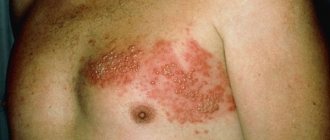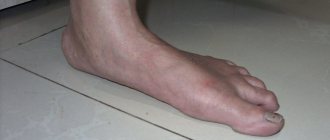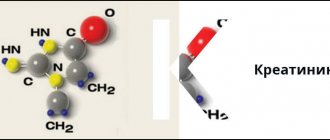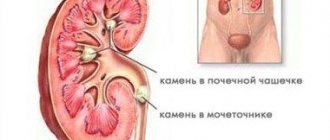Adult Still's disease (ADS) is a multisystem autoinflammatory disease characterized by uncontrolled inflammatory symptoms that affect a person's joints and internal organs. The frequency of development of this pathology may vary among representatives of different nations, but it is known that most often the disease occurs in women aged 16 to 35 years. This disease is classified as incurable, but treatment is necessary. Only timely and correct diagnosis and therapy will allow the patient to achieve remission and maintain it for a long time.
Something in this style
“Among fevers of unknown origin, or diseases accompanied by fever, Still’s disease in adults occupies a special place in rheumatology. It is this that represents an important problem of differential diagnosis for rheumatologists. The insidiousness of the disease lies not only in the fact that it is not easy to diagnose due to the lack of specific tests, but also in the fact that it can lead to life-threatening complications,” emphasizes Evgeniy Nasonov, Academician of the Russian Academy of Sciences, chief freelance rheumatologist of the Ministry of Health of the Russian Federation .
Although Still's disease has a number of characteristic symptoms, each patient experiences it differently. Symptoms are most often very individual, which, of course, complicates the diagnosis. And delaying treatment is dangerous, since in about a third of patients, Still's disease can lead to disability if it is not diagnosed in a timely manner. A fatal outcome is also possible, its risk ranges from 2.3% to 14%. Life-threatening complications of this disease include macrophage activation syndrome - the same “cytokine storm” that many are now well aware of in connection with the coronavirus. That is, the patient can be killed by his own immune system.
Diseases of Rapunzel and Diogenes. What unusual syndromes are people susceptible to? More details
The main symptoms of Still's disease are:
- systemic (daily) fever with a rise in body temperature above 39 °C;
- joint pain (arthralgia and arthritis);
- a sore throat;
- salmon-colored skin rash;
- changes in blood tests with signs of inflammation (>10,000/ml leukocytes and >80% neutrophils).
Affected Populations
The adult form of Still's disease affects men and women in equal numbers. Some medical literature suggests that the disorder affects women slightly more often than men. This primarily concerns young people aged 16 to 35 years. The incidence of the disease in adults is still unknown. Due to the highly variable symptoms and rarity of the disorder, it is often underdiagnosed or misdiagnosed, making it difficult to determine its true incidence in the general population.
School of Rheumatology
“When we talk about rare diseases, issues of differential diagnosis always come to the fore, because it is often extremely difficult to give the patient the correct diagnosis during the initial examination,” notes Professor, Director of the Federal State Budgetary Institution NIIR. V. A. Nasonova, Doctor of Medical Sciences Alexander Lila.
The expert explains that such care can only be provided to patients in an institution with a multidisciplinary team, where there are all the capabilities to carry out diagnostics and provide high-tech medical care within the same walls.
“If we talk about the Russian Federation as a whole, then specialists from the regions are often in dire need of advice to determine the algorithm for managing patients with Still’s disease. It will now be easier to obtain it thanks to the opening of a reference center for autoinflammatory diseases on the website of our institution,” says Lila. “Now a doctor of any specialty can receive correspondence consultation from federal experts if EFS is suspected in patients over 18 years of age.”
Possible complications and consequences
Still's disease is often complicated by pericarditis and (or) pleurisy. Every fifth patient develops aseptic pneumonitis, the clinical manifestations of which resemble bilateral pneumonia. This:
- fever;
- dyspnea;
- coughing.
Prescribing antibiotics for aseptic pneumonitis does not produce results.
Rarer complications of Still's disease are:
- cardiac tamponade;
- myocarditis;
- respiratory distress syndrome;
- valvular vegetations (proliferation of tissue of the heart valves).
The following can lead to death:
- liver failure;
- amyloidosis;
- heart failure;
- blood clotting disorders.
Comments
(function(w, d, n, s, t) { w = w || []; w.push(function() { Ya.Context.AdvManager.render({ blockId: 'RA-324974-4', renderTo : 'yandex_rtb_R-A-324974-4', async: true }); }); t = d.getElementsByTagName('script'); s = d.createElement('script'); s.type = 'text/javascript '; s.src = '//an.yandex.ru/system/context.js'; s.async = true; t.parentNode.insertBefore(s, t); })(this, this.document, 'yandexContextAsyncCallbacks ');»+»ipt>
- Automatic gates
- Wooden gates and fences
- Hedge
- Brick fences
- Fence and gate structures
- Metal fences and gates
- Fence and gate installation
- Answers on questions
- Finishing the fence and gate
- Fence and gate repair
- Advertising on the website
- Our specialists
Treatment
Acute illness
Nonsteroidal anti-inflammatory drugs (NSAIDs), including acetylsalicylic acid, are first-line drugs. Response to NSAIDs may be slow, but responders generally have a good prognosis.
The main problem associated with this treatment regimen is the severe hepatotoxicity of the drugs. Alterations in liver function tests are likely part of the disease, and these values may return to normal levels despite long-term NSAID therapy. However, for patients receiving NSAIDs, frequent monitoring of liver function is mandatory, even after discharge from the hospital. NSAIDs may also increase the risk of intravascular coagulopathy.
Patients who do not respond to NSAIDs, those with severe disease accompanied by the development of systemic intravascular coagulopathy; those who have elevated liver function test levels during treatment with NSAIDs, and people who do not respond to NSAIDs may require treatment with glucocorticoids. Typically, prednisone is initially required at 0.5 - 1 mg/kg per day, but relapse may occur when the dose is reduced, and long-term treatment does not prevent the progression of joint destruction. In case of a life-threatening acute form of the disease, intravenous drip administration of methylprednisolone is used.
Chronic illness
There are no published controlled studies of second-line agents for the treatment of Still's disease. The most common cause of chronicity is arthritis. To control both chronic arthritis and a chronic systemic process, weekly methotrexate is indicated in low doses similar to those used for rheumatoid arthritis in adults. Although methotrexate is potentially hepatotoxic, this agent is being used increasingly. Approximately two-thirds of patients respond to methotrexate. Moderate chronic systemic disease (eg, fatigue, fever, rash, serositis) may also respond to hydroxychloroquine, which can be combined with methotrexate. Increased toxicity of sulfasalazine has been reported, limiting its use.
In cases of resistance, immunosuppressive agents have been used, including azathioprine, cyclophosphamide and, more recently, cyclosporine A. Intravenous immunoglobulin, alone or in combination with mycophenolate mofetil, has been used with conflicting results.
Increased concentrations of serum cytokines, including TNF-α, IL-6, γ-IFN and especially IL-18, although nonspecific, give hope for the success of anti-pitokine treatment. TNF-α antagonists, especially infliximab, are effective, although a recent report noted that these drugs were discontinued in 17 of 20 patients due to side effects or loss of efficacy. The use of anakinra (100 mg, subcutaneously daily) is a promising treatment option. This drug was shown to be highly effective. A decade after disease onset, approximately one half of patients require second-line agents, and one third of them require low-dose glucocorticoids.
Adult-onset Still's disease primarily affects young people as they finish their education, begin a career, or start a family, which can make it especially devastating. Exercise therapy, occupational therapy, psychologists or arthritis support groups may be needed to care for individual patients. A knowledgeable, caring physician can make a huge difference
It is important to understand that Still's disease can subside even years after onset and that the vast majority of patients are living full lives a decade after the onset of the disease.
Features of the development of Still's disease in children
There are some differences in symptoms between adult arthritis and juvenile arthritis. Thus, the majority of sick children (about 90%) develop iridocyclitis.
The main symptoms vary depending on the form of the pathology.
In childhood, several factors contribute to the occurrence of Still's syndrome:
- physiology of the child's body;
- immunological features;
- frequent childhood infections;
- sensitivity to allergic reactions.
As a result of these factors, conditions are created that cause arthritis or specific clinical forms of rheumatoid arthritis.
Reasons for development
The causes of the disease at the present stage are not fully understood. The onset of the disease is quite acute, a febrile state is noted, which allows us to talk about its infectious origin. But a single pathogen could not be identified.
It is believed that the disease is caused at the genetic level and manifests itself under the influence of certain factors. They could be:
- bacterial infections;
- joint damage;
- viruses;
- vaccination during bacterial or viral infections;
- psycho-emotional stress;
- strong cooling of the body;
- prolonged exposure to the sun.
Inflammatory reactions in Still's disease have an autoimmune course, that is, native cells are accepted by the body as foreign, and the production of antibodies begins against them.
Against the background of juvenile rheumatoid arthritis, antibodies affect the joints, which leads to their inflammation, which becomes chronic. Further impact is reflected in the articular cartilage, which is gradually destroyed. The structure of the bones included in the affected area changes and their gross deformation occurs. Ultimately, this leads to inactivity of the joint or complete immobility.
Inflammatory reactions in Still's disease have an autoimmune course
What are the symptoms to recognize the disease?
Still's disease manifests itself in adults and children with the following symptoms:
- Fever and temperature increases up to 39 degrees with sudden changes: it can rise quickly and fall sharply.
- Skin rash. It appears when the temperature rises and is accompanied by itching in rare cases. Pink spots and bumps (papules) form on the skin of the torso, arms, legs, and rarely on the face. The rash may go away and appear again.
- Loss of appetite, nausea and vomiting.
- Arthritis. Inflammation of one joint begins, and over time many joints are involved in the process: polyarthritis develops.
- Enlarged lymph nodes, often cervical.
- Constant soreness and burning in the throat.
- Shortness of breath, cough.
- Enlarged liver and spleen.
Without timely treatment, Still's disease can be complicated by pleurisy, aseptic pneumonitis, myocarditis, pericarditis, and renal failure.
The main symptom is pain in all joints
A characteristic feature of the disease is inflammation of the distal interphalangeal joints of the hand, which is present in almost all patients. This sign helps distinguish the disease from rheumatoid arthritis .
Readers often study along with this material:
- Proper nutrition to combat the development of joint arthritis
- Massage and folk remedies for the treatment of arthritis of the fingers
Cytostatics and biological drugs
Cytostatic drugs include Methotrexate, Arava, Remicade, Equoral, Cyclophosphamide and many other drugs. Most often used in the treatment of juvenile rheumatoid arthritis:
- Methotrexate. “Gold standard” in the treatment of diseases of the musculoskeletal system. The required dosage is selected individually, but on average it is enough to take 1 tablet every 7 days. The effect of its use develops after 5-6 weeks from the start of use. The maximum concentration of the substance in the blood is reached after 6-12 months.
- Arava. Prescribed in case of side effects from taking Methotrexate. Begins to act in 4-6 weeks.
- Remicade. It has a faster therapeutic effect, but has a fairly large list of contraindications. It is used only in the absence of proper results from taking other basic drugs. Requires simultaneous administration of antihistamines, as it can provoke the development of an allergic reaction.
Biological drugs quickly and very effectively relieve inflammation. However, they also have some disadvantages. They can only be used in a hospital setting, since this group of drugs must be administered under the supervision of a physician. The duration of drug administration ranges from 30 minutes to 2 - 3 hours, depending on the chosen dosage. This group of medications includes:
- Etanercept. Provides an increase in the transport of leukocytes to the site of the inflammatory process, thereby enhancing the immune response.
- Anakinra. Has an inhibitory effect on Interleukin-1. As a result, the activation of inflammatory cells becomes impossible.
- Orence. It is the drug of choice in case of ineffectiveness of other basic drugs, in particular Methotrexate. Often used in the treatment of children.
- Actemra. Neutralizes Interleukin-6, which is one of the main mediators of inflammation. Used as monotherapy or combined with Methotrexate.
- Rituximab. Reduces the number of lymphocytes and prevents the progression of the inflammatory process.
Sources
- https://okeydoc.ru/bolezn-stilla-u-vzroslyx-iu-detej-simptomy-lechenie/
- https://www.neboleem.net/bolezn-stilla.php
- https://diartroz.ru/artrit/revmatoidnyy-artrit/bolezn-stilla-i-felti.html
- https://NogivNorme.ru/bolezni/artrit/vidy-artritov/bolezn-stilla.html
- https://medbe.ru/materials/klinicheskie-rekomendatsii/bolezn-stilla-u-vzroslykh/
- https://www.syl.ru/article/299139/bolezn-stilla-prichinyi-simptomyi-diagnostika-i-osobennosti-lecheniya
- https://lechenierebenka.ru/bolezn-stilla-u-detej/
- https://sustavy-lechenie.ru/bolezn-stilla-vzroslykh-detey-priznaki-simptomy-lechenie/
- https://liqmed.ru/disease/bolezn-stilla/
- https://DetStrana.ru/service/disease/children/bolezn-stilla/
- https://OrtoCure.ru/kosti-i-sustavy/artrit/bolezn-stilla-u-vzroslyh.html
Methods of therapy
The goals of treatment for Still's disease are:
- pain relief;
- prevention of systemic lesions;
- improving the patient's quality of life;
- prevention of re-development of pathology.
They are achieved through a complex effect on the disease. It includes:
- General recommendations that include:
- weight loss;
- exercise therapy;
- quitting smoking and alcohol;
- prevention of acute infectious diseases.
- Medication prescriptions.
- Physiotherapeutic procedures: electrophoresis, magnetic therapy.
- Therapeutic massage when the acute inflammatory process subsides.
Only a rheumatologist determines a treatment regimen with specific medications, dosages and frequency of administration! For medicinal effects on the manifestations of Still's disease, 3 groups of drugs are used:
- Non-steroidal anti-inflammatory NSAIDs:
- Nimulid, Nise, Nimika;
- Movalis;
- Naproxen;
- Aertal.
Prescribed for a long term at all stages of the disease. If there is a history of peptic ulcer disease, then they are combined with proton pump inhibitors (Omez, Lancid).
- Glucocorticosteroids – Metypred, Prednisolone. Indications for their use:
- advanced and late stage;
- intolerance to NSAIDs;
- exacerbation of gastric or duodenal ulcer;
- ineffectiveness of the main therapy.
The duration of their use varies individually, but on average is up to 3 months. Abrupt discontinuation of this group of medications is contraindicated, which is associated with a high risk of worsening the condition. The dosage is reduced gradually.
Rheumatologists call the administration of hormones at the same time as starting basic medications as bridge therapy.
- Immunosuppressive drugs are prescribed in the presence of systemic lesions and severe joint deformities for a long period. For Still's disease it is recommended:
- Methotrexate, Methoject (at the same time, taking folic acid is indicated, which reduces the risk of developing undesirable effects);
- Cyclophosphamide;
- Remicade (has fewer adverse reactions and a high price category).
The listed drugs are called basic. When taking them, laboratory monitoring of general blood parameters is required. If there is a marked decrease in red blood cells, hemoglobin, platelets or leukocytes, then medications are temporarily discontinued.
ARVE Error: id and provider shortcodes attributes are mandatory for old shortcodes. It is recommended to switch to new shortcodes that need only url
Of secondary importance is the use of metabolic drugs that improve blood circulation and nutrition in damaged structures. These include injections of Pentoxifylline, Trental, Nicotinic acid. They are used in hospitals in the absence of contraindications.
Causes and risk factors
The exact causes of Still's disease are unknown. The infectious nature of the disease is indicated by high fever, lymphadenopathy, leukocytosis, and sudden onset. However, it has not yet been possible to identify a single pathogen. In some patients, cytomegalovirus is isolated, and in others, rubella virus is isolated. The literature describes cases of Still's disease associated with Escherichia, mycoplasma, Epstein-Barr viruses and parainfluenza.
The exact causes of Still's disease are unknown, but many symptoms indicate an infectious nature of the disease
Some patients experience a combination of Still's disease and allergic vasculitis. This circumstance suggests an autoimmune genesis of the disease.
Measures to prevent Still's disease have not been developed, since the mechanism of its occurrence is unclear.
The presence of a hereditary predisposition cannot be completely ruled out, although precise data have not yet been obtained confirming the connection between the pathology in question and the HLA (human leukocyte antigen) loci.
How does pathology develop?
Only joints or joints and internal organs can be affected by this disease. Accordingly, two forms of pathology are distinguished: articular and articular-visceral.
The articular form of the disease can manifest itself as:
- polyarthritis, when the inflammatory process involves more than three joints;
- oligoarthritis with damage to 2 or 3 joints;
- monoarthritis with inflammation of the 1st joint.
The course of juvenile rheumatoid arthritis can vary in intensity:
- high;
- moderate;
- low;
- remission.
The initial manifestations are muscle and joint pain with an increase in body temperature.







